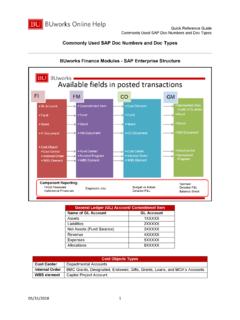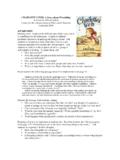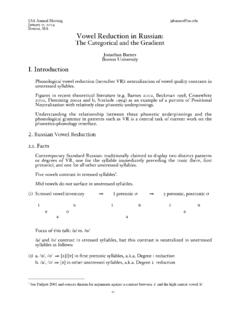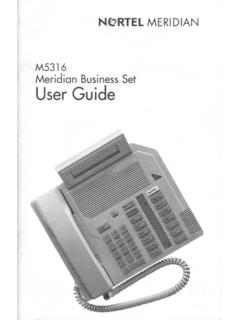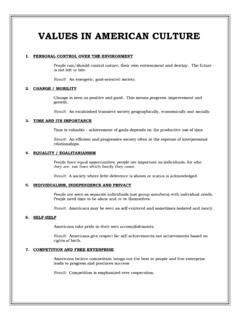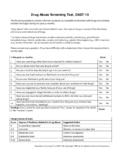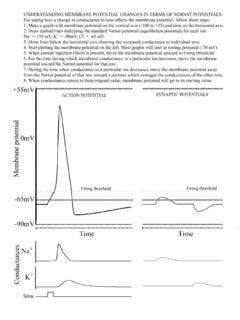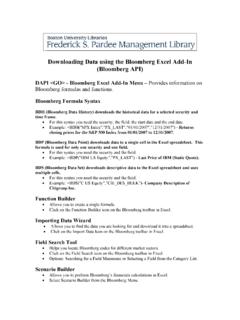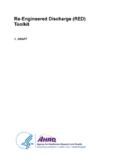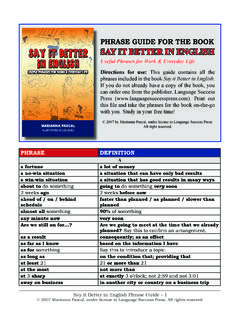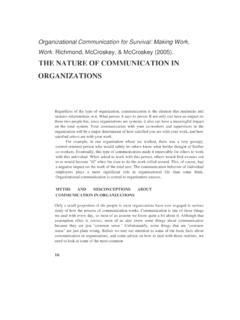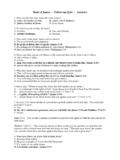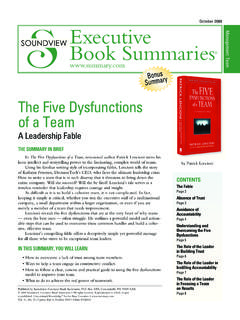Transcription of CAS LX 522 Back to the trees: X-bar Theory Syntax I
1 1 Week 3. X-bar TheoryCAS LX 522 Syntax IBack to the trees: X-bar Theory Consider our current NP rule: NP: (D) (AdjP+) N (PP+) This yields a flat structure where all of thecomponents of DP c-command each PNPofNPPpoemsPNPwithDAdjPtheNcoverAdjblu eAdjPAdjbigX-bar Theory : NP I bought this big book of poems with the blue cover. You bought this small PNPofNPPpoemsPNPwithDAdjPtheNcoverAdjblu eAdjPAdjbigX-bar Theory : NP We can substitute one for book of poems with the bluecover, which should mean book of poems with the bluecover is a constituent, but it isn t in our PNPofNPPpoemsPNPwithDAdjPtheNcoverAdjblu eAdjPAdjbigX-bar Theory : NP I bought this small one with the red cover. We can also substitute one in for book of poems alone,which should thus also be a PNPofNPPpoemsPNPwithDAdjPtheNcoverAdjblu eAdjPAdjbigX-bar Theory : NP This suggests a more deeply embedded structure:?
2 DNPP thisbook PNPofNPPpoemsPNPwithDAdjPtheNcoverAdjblu eAdjPAdjbig?NP2X-bar Theory : NP We ll call these intermediate nodes of NP N (N-bar). Notice that you can also say I bought this DNPP thisbook PNPofNPPpoemsPNPwithDAdjPtheNcoverAdjblu eAdjPAdjbigN NPX-bar Theory : NP So, our final NP looks like this:N DNPP thisbook PNPofNPPpoemsPNPwithDAdjPtheNcoverAdjblu eAdjPAdjbigN NPN X-bar Theory : NP We need to break up our NP rule; instead of NP: (D) (AdjP+) N (PP+) We have: NP: (D) N N : AdjP N N : N PP N : N (PP) Notice that these yield the same results on the surface(note the recursion and the optionality) but producedifferent structures (in terms of constituency). Notice also that under these rules, any node of NP hasno more than two daughters (binary branching). X-bar Theory : VP The same kind of thing holds of VP as wellas NP.
3 Instead of using one (which standsfor N ) we can try doing replacements usingdo so, and we ll get a very similar result. Our old rule generated a flat structure forVP as well (all PPs, NPs, CPs, etc. in a VPc-command each other). VP: (AdvP+) V ({NP/CP}) (PP+) (AdvP+) X-bar Theory : VP VP: (AdvP+) V ({NP/CP}) (PP+) (AdvP+) I quickly left after Mary did so. I left quickly after Mary did so. I ate the pizza with gusto and Mary did sowith quiet reserve. I ate the pizza with gusto immediately andMary did so Theory : VP Again, it looks like we need to break our rule intoparts using V (for which do so can substitute). VP: (AdvP+) V ({NP/CP}) (PP+) (AdvP+) To: VP: V V : AdvP V V : V PP V : V AdvP V : V ({NP/CP}) Again, this is the (almost) same on the surface, butyields a different structure. And again, Theory : VP Our new rules do not quite make the samepredictions about the surface strings of VPs,however.
4 The old rules had (PP+) before(AdvP+), the new rules allow them tointermingle. But that s actually better: John grabbed the book quickly from the tabletriumphantly. John grabbed the book off the table quicklywith a devilish grinX-bar Theory : AdjP We should now be growing suspicious of our otherrules, now that we have had to split up NP and VP andintroduce N and V nodes. The governor was [AdjP very concerned about housing costs ];the tenants were [AdjP even more so ]. The studio was [AdjP unusually pleased with its actors andconfident of success ]. The first statement was true; the second was less so. This gives us evidence of AdjP: (AdvP) Adj Adj : Adj (PP) X-bar Theory : PP The frisbee landed on the roof. It landed right on the edge. John knocked it right off the roof and into the trashcan. Mark was at odds with his supervisor.
5 Mark was in love and at odds with his supervisor. So, this gives us (assuming right is an AdjP): PP: (AdjP) P P : P (PP) P : P DPX-bar Theory PP: (AdjP) P P : P (PP) P : P DP NP: (D) N N : AdjP N N : N PP N : N (PP) The main idea behind X-bar Theory is toexplain the similarity between the rules foreach category. It is an attempt to generalizeover the rules we have. AdjP: (AdvP) Adj Adj : Adj (PP) VP: V V : AdvP V V : V PP V : V AdvP V : V ({NP/CP}) X-bar Theory PP: (AdjP) P P : P (PP) P : P DP NP: (D) N N : AdjP N N : N PP N : N (PP) The X in X-bar Theory is a variable overcategories. When we talk of XP, we meanto be describing any kind of phrase (VP, NP,AdjP, AdvP, PP, TP, CP, ..). AdjP: (AdvP) Adj Adj : Adj (PP) VP: V V : AdvP V V : V PP V : V AdvP V : V ({NP/CP}) X-bar Theory PP: (AdjP) P P : P (PP) P : P DP NP: (D) N N : AdjP N N : N PP N : N (PP) The rules all have the following form: XP: ZP X X : (YP) X X : X (YP)X : X (WP) AdjP: (AdvP) Adj Adj : Adj (PP) VP: V V : AdvP V V : V PP V : V AdvP V : V ({NP/CP})4X-bar Theory X-bar Theory elevates this to a principle of phrasestructure; it hypothesizes that all phrases in a syntactictree conform to this template.
6 XP : (ZP) X A phrase (XP) consists of optionally another phrase and a bar-level projection (X ). X : YP X or X : X YP A bar-level projection (X ) can consist of another X and anotherphrase (recursive). X : X (WP) A bar-level projection (X ) consists of a head of the samecategory (X) and optionally another Theory Structurally, this looks like this(of course, there can be anynumber of X nodes, here we seethree). Different parts of this structureare given different names (andthey act different from oneanother, as we ll see).ZPX YPXWPX X XPYPX-bar Theory The phrase which is immediatelydominated by XP (designated ZPhere) is the specifier. A phrase dominated by X andthe sister of X is an adjunct. The phrase which is sister to X isthe YPXWPX X XPYPX-bar Theory We have posited a structuraldifference between complements(WP here, of which there is onlyone) and adjuncts (YP here, ofwhich there can be any number),and so we should expect to findthat they behave differently.
7 Consider YPXWPX X NPYPX-bar Theory : NP The head of this NP is DNPP thebook PNPofNPPpoemsPNPwithDAdjPtheNcoverAdjblu eAdjPAdjbigN NPN X-bar Theory : NP The head of this NP is book. The complement is of DNPP thebook PNPofNPPpoemsPNPwithDAdjPtheNcoverAdjblu eAdjPAdjbigN NPN 5X-bar Theory : NP The head of this NP is book. The complement is of poems. With the blue cover and big DNPP thebook PNPofNPPpoemsPNPwithDAdjPtheNcoverAdjblu eAdjPAdjbigN NPN X-bar Theory : NP The head of this NP is book. The complement is of poems. With the blue cover and big areadjuncts. The is in specifier DNPP thebook PNPofNPPpoemsPNPwithDAdjPtheNcoverAdjblu eAdjPAdjbigN NPN Note: D here is nota phrase; it does notconform to X-bartheory. We will fixthis Theory : NP The complement of a head ( , of poems in abook of poems) tends to feel more intimatelyrelated to the head.
8 Compare a book on the table. The complement of N in English is almost alwaysintroduced by the preposition of. X-bar Theory allows for only one complement, andindeed in NP we cannot have two of-PPs of thissort: *The book of poems of fiction Cf. The book of poems and of fictionX-bar Theory : NP An adjunct, on the other hand, feels more optional A book on the table X-bar Theory allows for any number of adjuncts (notjust one, like with complements). The book with the blue cover on the third shelf about C++ Adjuncts can generally be re-ordered freely. The book with the blue cover about C++ on the third shelf The book about C++ with the blue cover on the third shelf The book about C++ on the third shelf with the blue cover The book on the third shelf with the blue cover about C++ The book on the third shelf about C++ with the blue coverX-bar Theory : NP X-bar structure also predicts that thecomplement PP of an NP must be first;it cannot be re-ordered with respect toadjunct PPs.
9 The book of poems with the blue cover onthe third shelf *The book with the blue cover of poemson the third shelf *The book on the third shelf of poemswith the blue cover *The book with the blue cover on thethird shelf of poemsZPX YPXWPX X XPYPX-bar Theory : NP Other tests differentiate adjuncts and complements too. Conjoining two elements of a given category yields anelement of the same category; if conjunction is possiblethe two conjuncts are of the same category. You cannot conjoin a complement and an adjunct PP(where could it go in the structure?), although you canconjoin complements and you can conjoin adjuncts: The book of poems and of essays The book with the blue cover and with the red spine *The book of poems and with the red spine6X-bar Theory : NP Finally, recall our one-replacement test. One canstand in for an N , but notfor an N.
10 This predicts that youshould not ever be able toget one followed by acomplement PP; Oneshould only be able to befollowed by adjunct YPXWPX X XPYPOne would replacean X Theory : NP And this prediction is met: The book of poems on the third shelf The one on the fourth shelf *The one of essays on the third shelf So, X-bar structures seem to accuratelycharacterize the structure of the Theory : NP Adjuncts do not have to be on theright, as all of the PP s that we velooked as so far have been. Left-handed adjuncts to NPinclude AdjP, like: The very big book of poems The big red boring book of poems The big boring red book of poemsZPX YPXWPX X XPYPX-bar Theory : NP In fact, it appears that complements do not alwayshave to be on the right. A complement is thephrase which is sister to the head, but either ofthese structures has a complement , there can be only one NXPN XPNX-bar Theory : NP An example of a left-sided complement islinguistics in linguistics book.
